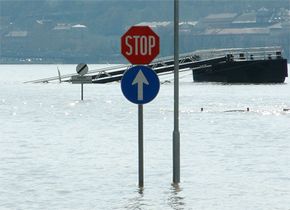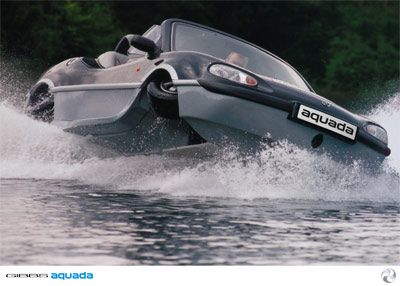In a lot of movies and military documentaries, you see Jeeps and military trucks nearly submerging themselves as they cross a river. These Jeeps and trucks can do it, but what would happen if you tried to drive your car through a shallow river or a 4-foot deep pond? Your car would die almost immediately. So what's the difference?
If you think you can drive your car underwater, think again. It would stop running almost immediately.
Advertisement
Creating a vehicle that can run submerged is a challenge. In order for any type of combustion engine to run, it must have a source of air and it must be able to release exhaust gasses. If the water isn't too deep (a few feet), the exhaust gases can take care of themselves, because they come out with the engine under pressure.
The air intake is usually the problem. As soon as you submerge the air intake, the engine can no longer get air and it will stop running. You can get around the air intake problem by adding a snorkel to the system. For example, military Humvees often have a snorkel attached to a port on the passenger side of the hood. The snorkel allows them to submerge in up to 5 feet (1.6 meters) of water while still getting air.
Then you have to waterproof the engine. There are a lot of different issues to think about. For example:
- Any electrical devices like instruments, engine control computers, motors (for fans, windshield wipers, et cetera), lights and the battery, must be sealed.
- Any venting for items such as the crankcase and differential must be sealed (or vented at the same level as the snorkel).
- The fuel tank must be sealed and vented appropriately.
- Any chamber or crevice that can fill with water must have a drain.
If the air intake and exhaust have been taken care of and the engine has been completely waterproofed, then the vehicle can run underwater.
In general, waterproofing a diesel engine is easier than waterproofing a gasoline engine because of the ignition and sparkplugs in a gasoline engine. These components run at high voltage and sealing them is very difficult (but not impossible). A diesel engine, on the other hand, has no ignition system. Also, if the diesel engine has a mechanical fuel pump for the injectors and a mechanical transmission, there are no engine control electronics to worry about. These features can make a diesel engine relatively easy to waterproof. That's why most military vehicles that forge rivers or run submerged have diesel engines.
Advertisement



